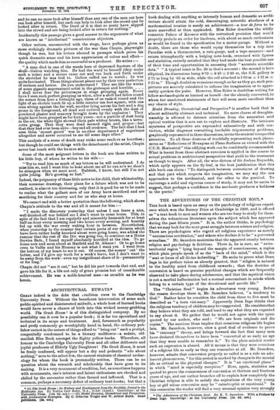ARCHITECTURAL BYWAYS.*
Gazer indeed is the debt that erudition owes to the Cambridge University Press. Without the beneficent intervention of some such public-spirited and disinterested midwife, a whole host of learned books would have never a chance of birth into this wicked money-grubbing world. The Greek House' 1. of this distinguished company. By no possibility can it ever be a popular book ; it is far too specialized and technical in its scope and treatment. And, forasmuch as popularity and profit eommonly go worshipfully hand in hand, the ordinary publisher cannot in the nature of things afford to " bring out" such a protigi, congenitally condemned to , be a literary wallflower—a sedate, oldmaidish Blue Book amongst the flighty yellow-backs. Wherefore, all honour to the Cambridge University Press and all other deliberate and joyful producers of Elderly Ugly Daughters! The Greek House, it must be freely confessed, will appear but a dry and pedantio "ado about nothing," save to the select few, the earnest students of classical archaeology for whom the book in presumably written. There can be no question about the research and scholarship that have gone to its making. It is a very monument of erudition, but, as sometimes happens with monuments, one's interest and latent enthusiasm are checked and chilled by the encounter rather than fanned and inflamed. That is a common, perhaps a necessary defect of ordinary text-books; but that a book dealing with anything so intensely human and domestic as *NWtecture should attain the cold, discouraging, scientific aloofness of • mathematical treatise is surely an achievement—a tour de force to be more marvelled at than applauded. Miss Rider describes the wildly romantic Palace of Knossos with the restrained precision that would properly prelude an order for linoleum, with about as much enthusiasm as would be found in the specification for a motor-garage. Without a doubt, there are those who would equip themselves for a trip into Paradise with a thermometer, a rain-gauge, and a tape-measure--and return triumphantly with a bulging note-book, crammed with figures and statistics, entirely satisfied that they had made the best possible use of their time and opportunities in amassing their "accurate sciontifie data." "A typical tomb is No. 30 in Ossi's account : the mound is here elliptical, its dimensions being 8.70 x 8.40 x 2.40 m, the S.E. gallery is 2.75 m long by 115 m wide, while the cell attached is 1.05 m x 1.31 inx • 1.25 m." Though doubtless veracious enough as far as they go, suoh pen. pictures are scarcely calculated to inflame the imagination or to appreciably quicken the pulse. However, Miss Rider is doubtless writing for fellow-archaeologists as learned as herself—for the already converted, to whom her unadorned statements of fact will seem more excellent than any charm of style.
Model Drawing, Geometrical and Perspective' is another book that is almost militantly abstract and technical. No mere charm of draughtsmanship is allowed to distract attention from the somewhat arid optical verities that it sets out to explain and illustrate. The intricate mysteries of perspective are expounded exhaustively and with conviction, whilst diagrams resembling insoluble trigonometry problems, graphically represented in three dimensions, invite the student's respectful attention. To all those desirous of truthfully representing suoh phenomena as " Reflections of Hexagons at Plano Surfaces as viewed with the C.U.R. Horizontal" this edifying work can be confidently recommended. What is learnt from these abstract exercises is applied in duo course to actual problems in arohitectural perspective that yield to the treatment as though to magic. After all, the wise dictum of Sir Joshua Reynolds, which aptly appears on the fly-leaf, is the best justification that this able book oan claim : "To distinguish between correctness of drawing and that part whioh respects the imagination, we may say the one approaohes to the mechanical, and the other to the poetical. To encourage a solid and vigorous courso of study, it may not be amiss to suggest, that perhaps a confidence in the mechanic produce. a beldame in the poetic."












































 Previous page
Previous page